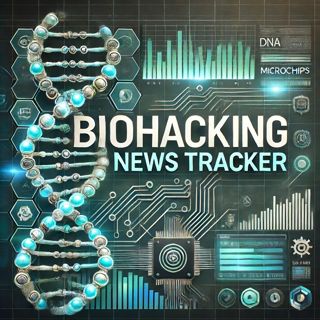
"Biohacking's Explosive Growth: Innovative Wellness Tech, Global Events, and the Future of Personalized Health"
The global biohacking industry has experienced significant momentum over the past 48 hours, highlighted by major upcoming events, new product launches, and a sharpening focus on long-term wellness and personalized health strategies. Anticipation is building for the Biohacking Conference 2025, set to take place in Austin, Texas, May 28 to 30, where more than 3000 attendees are expected to engage with over 100 innovative technologies focused on nutrition, sleep, brain enhancement, fitness, and longevity. Participation is robust, with ticket prices reflecting high demand at $1999 per general admission and a strong presence from industry leaders, including renowned entrepreneur Dave Asprey.Recent market movements indicate continued investment into the longevity and wearable tech sectors. Industry events are fueling partnerships between established companies and startups, particularly around nootropics, smart wearables, and personalized medicine. For example, the Biohackers World Conference in Los Angeles and the Biohacker Summit in Tokyo, both scheduled later this year, are attracting top researchers and visionary investors interested in the latest biotech solutions, metabolic health, and gut optimization.Consumer behavior is shifting toward a demand for holistic and scientifically validated approaches, with intermittent fasting, sleep optimization, and gut health interventions drawing increased attention. Notable new product pre-orders, such as Dave Asprey’s "Heavily Meditated" launching May 20, are testing the resilience of direct-to-consumer channels and digital engagement.While regulatory landscapes remained largely stable this week, discussions at recent scientific events point to an increased emphasis on validating biohacking claims with clinical research. Some emerging competitors are prioritizing transparency in product efficacy, aiming to address past consumer skepticism.A distinctive trend is the growing east-meets-west convergence, particularly evident with the upcoming Biohacker Summit in Japan, where a blend of holistic wellness and advanced biotechnology is expected to shape new market standards.Compared to previous reporting, the industry’s pace of innovation appears to be accelerating, with notable resilience in the wake of previous supply chain disruptions. Industry leaders are responding with collaborative research initiatives, pre-release product testing, and larger, more interactive conferences to maintain consumer trust and market leadership.This content was created in partnership and with the help of Artificial Intelligence AI
6 Maj 2min

Biohacking Surge: Transforming Wellness and Brain Optimization
In the past 48 hours, the biohacking industry has shown significant momentum, with a major focus on new technology launches, prominent events, and a wave of innovative partnerships. Anticipation is building for the 2025 Biohacking Conference in Austin later this month, which will host over 4000 attendees and feature more than 100 of the latest biohacking products and technologies. Leaders like Dave Asprey are driving the field forward, introducing new developments such as his forthcoming book "Heavily Meditated" that blends neuroscience with practical biohacking for enhanced brain states. This event highlights an industry pivot toward holistic health and brain optimization, with keynotes from global humanitarians and resilience experts, suggesting an increased intersection between wellness and social impact.A recent launch by Zenos Health in the last 48 hours demonstrates the ongoing push for advanced at-home biohacking solutions, emphasizing personalized wellness and self-optimization through new digital platforms. Zenos Health’s approach—originating from a startup founder passionate about molecular-level health interventions—signals growing competition in the direct-to-consumer technology segment of the industry, which has seen notable investment and expansion this week. The supply chain appears stable, with no major disruptions reported, and price points for high-end consumer products remain elevated as premium features are added.Comparing to earlier this year, the sector has shifted from niche self-experimentation to more structured events and scientific gatherings, as seen by the calendar of multinational conferences in the US and Japan that are now attracting both startups and major tech players. Consumer demand is trending toward measurable benefits in longevity, cognitive function, and metabolic health, and there is growing interest in science-backed wearable biotechnology. So far this week, no major new regulatory changes have been reported, but increased scrutiny is being observed around claims and data privacy as growth accelerates.Industry leaders are responding to current challenges by emphasizing transparency, safety, and access to the latest research, using global conferences and influencer-driven communication to educate and engage. This marks a clear move toward mainstream acceptance and collaborative innovation in the biohacking sphere, compared to more fragmented efforts seen previously.This content was created in partnership and with the help of Artificial Intelligence AI
2 Maj 2min

Biohacking Boom: The $109 Billion Industry Transforming Personal Health and Human Optimization
BIOHACKING INDUSTRY: CURRENT STATE ANALYSISThe biohacking market continues its explosive growth trajectory, on pace to reach $45.16 billion in 2025, up from $36.61 billion in 2024—representing a remarkable 23.4% compound annual growth rate. Industry experts project further acceleration, with the market expected to more than double to $109.46 billion in the coming years[5].This growth is evidenced by the increasing prominence of major industry events. The upcoming Biohacking Conference 2025, hosted by industry pioneer Dave Asprey in Austin, Texas from May 28-30, is expected to draw over 4,000 attendees in its 13th year[2][3]. The event will showcase over 100 biohacking technologies and feature notable speakers including global humanitarian Martin Luther King III and leader Arndrea Waters King[2].Asprey's influence in the industry continues to expand with his new book "Heavily Meditated" scheduled for release on May 20, 2025, just before the conference. The book combines neuroscience with practical biohacking techniques aimed at achieving altered states of consciousness without extensive practice[2].The global landscape for biohacking is diversifying, with other major events planned throughout 2025, including the Biohackers World Conference & Expo in Los Angeles (March 29-30) and the Biohacker Summit in Tokyo (October 10-11). The Tokyo event will feature over 45 industry-leading speakers and approximately 650 attendees, highlighting the growing international interest in biohacking technologies[3].Consumer interest is expanding beyond core enthusiasts, with increasing focus on wearable technology, nootropics, cellular health, and personalized medicine. The intersection of biotechnology and consumer wellness continues to drive innovation, with infrared wellness technologies gaining particular attention as evidenced by their promotion at the upcoming Austin conference[4].This robust growth reflects broader trends in health consciousness, information accessibility, and the quantified self-movement, positioning biohacking at the forefront of personal health optimization and human performance enhancement.This content was created in partnership and with the help of Artificial Intelligence AI
1 Maj 2min

Biohacking Boom: Personalized Health Tech Drives Rapid Industry Growth
In the past 48 hours, the biohacking industry has demonstrated ongoing momentum, underscored by new product launches, robust market expansion, and the emergence of new competitors. The global biohacking market currently stands at an estimated 28.2 billion dollars for 2025, and recent forecasts predict that it could reach 111.3 billion dollars by 2034, with a compound annual growth rate of 9.5 percent over the next decade. This represents a significant acceleration compared to previous years, driven largely by consumer interest in personalized health technologies and self-optimization tools[2][4][5].Major industry players—such as Fitbit, Oura Health, Senseonics, and WHOOP—collectively hold about 45 percent of the market. They are maintaining their lead through continuous innovation, product rollouts, and strategic partnerships with both research institutions and government agencies. This week, Barentz International introduced a new collection called Skin’telligent Beauty, featuring biohacking-driven skin care formulations targeting longevity and skin health by influencing epigenetic regulation and the skin microbiome[3][4].Market disruptions have been relatively limited in the last two days, but there is heightened attention to regulatory review, especially as self-administered testing kits and wearable sensors grow more advanced and accessible. No major regulatory changes have been reported in this immediate window, but increased scrutiny is anticipated as the sector matures.Consumer behavior continues to shift toward proactive health management, with a stronger demand for data-driven products and solutions that offer personalized insights. Notably, there has been a visible uptick in social media discussions related to early disease detection, boosting public awareness and adoption of biohacking tools[4].Supply chain stability has persisted, with leading companies leveraging global distribution networks to ensure product availability. While prices for sophisticated wearables and testing kits have remained relatively flat this week, increased competition may exert downward pressure in the months ahead.In summary, the biohacking industry is experiencing robust growth, product innovation, and heightened consumer engagement. Compared to earlier cycles, the current period is marked by increased mainstream adoption and sophistication, positioning biohacking as a central trend in the future of personalized health[2][4][5].This content was created in partnership and with the help of Artificial Intelligence AI
29 Apr 2min

Biohacking Industry Booms to $111.3B by 2034 as Personalized Health Tech Gains Traction
Biohacking Industry Update: April 2025The biohacking market continues to show robust growth, with recent data indicating the global market size has reached $28.2 billion in 2025, up from $24.5 billion in 2024. Industry analysts project the market will expand dramatically to reach $111.3 billion by 2034, representing a compound annual growth rate of 9.5% over the next decade.In the last 48 hours, a detailed industry report released by Exactitude Consultancy highlighted key players dominating the space, including 23andMe, DNAfit, Theranos, LifeSpan, and HVMN. The report, published yesterday, points to personalized health technologies such as nutrigenomics and implantable devices as gaining significant traction.Notable recent developments include Barentz International's announcement earlier this month of their "Skin'telligent Beauty" collection - featuring 10 advanced formulations targeting biohacking and longevity trends in the personal care sector. This innovative line focuses on enhancing the skin's natural functions through ingredients targeting epigenetic regulation, glycation, senescence, and microbiome balance.Market segmentation insights reveal wearables currently lead the biohacking market with a 30.3% share, driven by smartwatches, fitness trackers, and continuous glucose monitors. However, DIY biology is emerging as the fastest-growing sector as consumer interest in self-experimentation increases.By application, diagnosis and treatment holds the largest market share at 34.1%, though cognitive enhancement is showing the fastest growth, fueled by demand for nootropics, neurostimulation devices, and biofeedback techniques.Industry challenges include regulatory hurdles and ethical concerns, which may potentially restrain market expansion despite mainstream acceptance of wearables and DIY biology driving overall growth.As biohacking continues to revolutionize personal health management, the integration of artificial intelligence and improved sensor technology in real-time health monitoring solutions represents a significant frontier for industry development in 2025.This content was created in partnership and with the help of Artificial Intelligence AI
28 Apr 2min

Biohacking Boom: The Surging Market for Personalized Health Tech
The biohacking industry has seen rapid developments over the past 48 hours, continuing its robust expansion as projected by market analysts. Current data shows the global market is expected to grow from 28.2 billion dollars in 2025 to 111.3 billion dollars by 2034, with an annual growth rate of 16.5 percent. Recent reports confirm that the wearables segment, which includes smartwatches, fitness trackers, and continuous glucose monitors, remains the dominant force, accounting for 30.3 percent of the market share in 2023 and continuing to surge this week. Demand for real-time health monitoring and personalized insights is driving strong sales, as is the integration of Artificial Intelligence and improved biosensors. The diagnosis and treatment sector holds the largest segment at 34.1 percent, fueled by advances in genomics and precision medicine. DIY biology and cognitive enhancement, particularly through nootropics and neurostimulation devices, are recognized as the fastest-growing subsectors within the past week. Industry leaders like Dave Asprey are currently preparing for upcoming major conferences—such as the Biohacking Conference in Austin this May—focusing on the latest innovations in wearable technology, nootropics, and cellular health. There have been no major regulatory changes or market disruptions reported this week. However, the industry is proactively responding to growing consumer interest in self-experimentation by accelerating product development, especially in the DIY and cognitive enhancement spaces. Major players are also deepening partnerships, particularly with biotech firms and wearable tech startups, to maintain their competitive edge. Supply chain conditions remain stable, with no significant bottlenecks or price fluctuations observed in the wearables and supplements categories. Compared to prior months, consumer behavior is shifting more decisively towards personalized, data-driven health solutions, reflected in recent spikes in both hardware and software sales for biohacking products. The balance of market power is slowly tilting towards new entrants specializing in AI-powered biofeedback and neurotech solutions, signaling heightened competition for established brands. In summary, the industry is marked by strong growth, stable supply channels, rapid innovation, and an increasing consumer appetite for advanced, individualized health optimization.This content was created in partnership and with the help of Artificial Intelligence AI
23 Apr 2min

The Rise of Biohacking: Personalized Wellness and the 111.3 Billion Dollar Industry
The biohacking industry is experiencing rapid evolution fueled by both consumer interest and technological advancement in the past 48 hours. Leading research projects that the global biohacking market will reach approximately 28.2 billion dollars in 2025 and surge to about 111.3 billion dollars by 2034, driven by a robust compound annual growth rate of 16.5 percent. The four dominant companies Fitbit, Oura Health Oy, Senseonics, and WHOOP collectively hold around 45 percent of the overall market share. They maintain their lead through high-profile partnerships, rapid product launches, and strong regulatory engagement.Recent days have seen heightened attention to personalized wearable devices, with wearables accounting for over 30 percent of product market share in 2023. The latest wave of devices includes improvements in sensor accuracy and the integration of artificial intelligence, enabling even more granular real-time health monitoring. Demand remains especially strong for continuous glucose monitors and smart health trackers that offer actionable personalized data. The fastest-growing sector, however, is the DIY biohacking sphere. More consumers are experimenting with nootropics, neurostimulation, and self-tracking for both cognitive enhancement and physical performance. These trends reflect a shifting mindset toward taking control over one’s biology, not just relying on traditional healthcare.The diagnosis and treatment application segment now makes up over one third of the market, largely due to advances in genomics, nutrigenomics, and precision medicine which allow for ultra-targeted wellness interventions. This growing intersection with healthcare has prompted regulators in both the US and Europe to fast-track reviews of wearable devices and certain supplements in recent days, aiming to balance encouraging innovation with maintaining safety standards.In beauty and health, the adoption of DNA-based skincare and microbiome assessments has gained traction among leading brands. New launches feature peptides, stem cells, and NAD plus boosters targeting anti-aging at the cellular level. Meanwhile, biohacking-enabled skincare is increasingly focused on supporting skin resilience and cellular repair rather than aggressive treatments, with skin fasting and multi-protection SPFs becoming mainstream.Overall, the industry is navigating continued supply chain volatility, especially for microchips and rare biochemicals, but large players are adapting by diversifying sources. Compared to previous periods, there is a definitive shift toward personalized, science-backed solutions and a democratization of biohacking, with both mainstream and niche players responding quickly to heightened consumer demand for data-driven, proactive self-care.This content was created in partnership and with the help of Artificial Intelligence AI
22 Apr 3min

The Booming Biohacking Sector: Innovation, Wearables, and the Rise of Personalized Health
The biohacking industry has seen marked activity in the past 48 hours, continuing its robust growth trajectory. Market analysts estimate the global biohacking sector to hit 28.2 billion dollars this year, with projections of reaching over 111 billion dollars by 2034 at a compound annual growth rate of 16.5 percent. The sector remains concentrated, with the top four players Fitbit, Oura Health, Senseonics, and WHOOP, controlling around 45 percent of the market. These leaders are reinforcing their positions through continuous product innovation, new product launches, and strategic alliances, especially with research institutes and government agencies, to accelerate regulatory approvals and technology adoption.Recent market trends highlight a surge in wearables, now accounting for more than 30 percent of biohacking product sales. Advanced smartwatches, glucose monitors, and biosensor-integrated fitness trackers are now at the center of consumer demand. The diagnosis and treatment segment retains the largest market share, with 34.1 percent, propelled by increased public interest in early detection and precision medicine. Additionally, cognitive enhancement is the fastest-growing application, reflecting the popularity of nootropics and neurostimulation devices.Emerging competitors like Thync, HVMN, Neurohacker Collective, and 8 Sleep are gaining traction with new launches and differentiated approaches, such as DIY biology and home neurostimulation kits. Meanwhile, DIY biohacking continues to rise sharply as consumers demand more personalized interventions and experiment at home.No major regulatory shocks have been reported this week, but market leaders remain vigilant, expanding compliance teams and investing in safety research in anticipation of increased scrutiny. Price changes remain stable, although some supply chain adjustments have occurred as manufacturers react to shifting demand for particular biosensors and raw materials.Consumer behavior has notably shifted towards passive physiological optimization, with practices like sauna use and real-time health monitoring outpacing more active interventions. Compared to previous quarters, current activity signals ongoing momentum in both mainstream adoption and experimental self-hacking subcultures. Biohacking leaders are responding by accelerating R and D and expanding wellness partnerships, aiming to capitalize on heightened public awareness of health optimization and chronic disease prevention.This content was created in partnership and with the help of Artificial Intelligence AI
21 Apr 2min





















